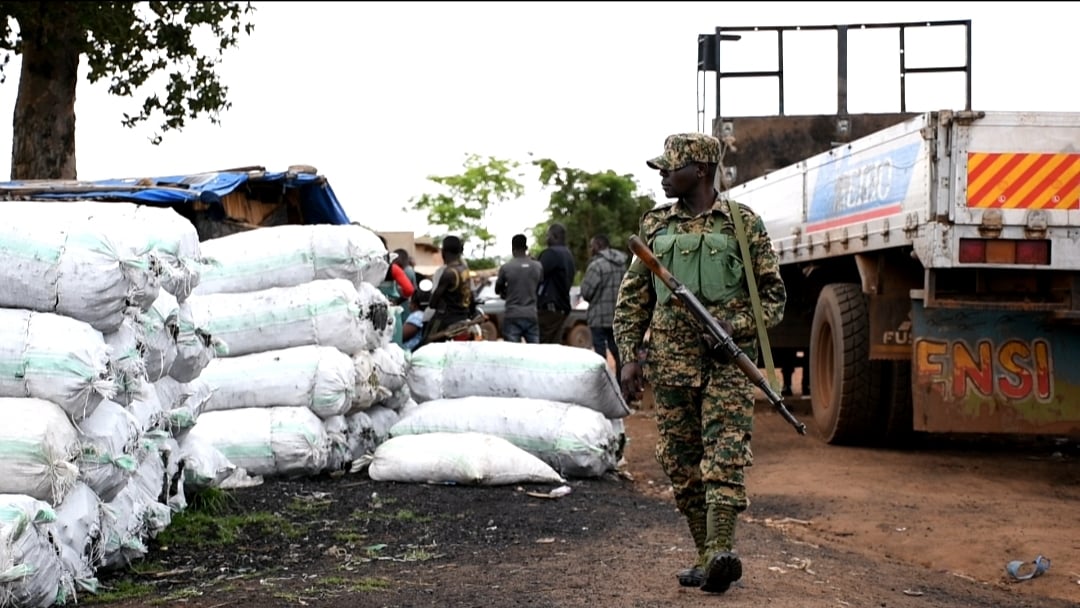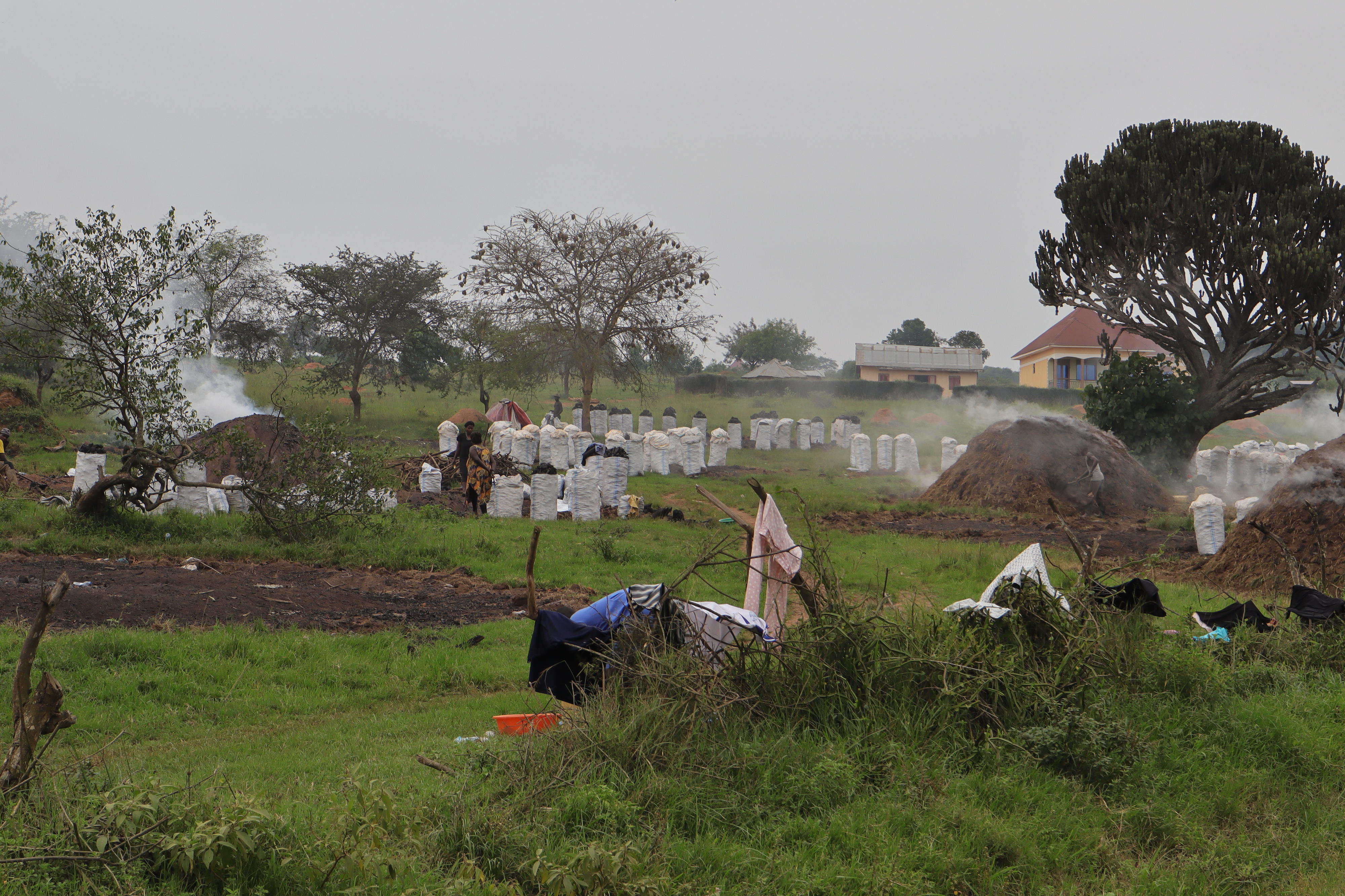
A Uganda People’s Defence Forces soldier at one of the charcoal camps at Apaa Junction in Mungula Parish, Itirikwa Sub-county in Adjumani District on April 18, 2023. PHOTO | TOBBIAS JOLLY OWINY
|Special Reports
Prime
Charcoal burning devastates landscapes in northern Uganda
What you need to know:
- GFW indicates that by 2023, the Lango sub-region – which comprises the districts of Otuke, Lira, Dokolo, Apac, Oyam, Kole and Kwania – had lost 631 hectares of tree cover, an equivalent of 404.3 thousand tonnes of carbon emissions. On the other hand, by 2023, the Acholi districts of Gulu, Nwoya and Omoro had lost a combined 2.8 thousand hectares of forest cover, an equivalent of 1.4 million tonnes of carbon emissions, writes
Deforestation in the northern part of the country is exacerbating the climate crisis. The Global Forest Watch (GFW), an online forest monitoring and alert system, reports that in 2010, Uganda had 6.92 million hectares of natural forest. However, by 2023, the country had lost 68.7 thousand hectares of natural forest, equivalent to 36.3 million tonnes of carbon emissions.
GFW indicates that by 2023, the Lango sub-region – which comprises the districts of Otuke, Lira, Dokolo, Apac, Oyam, Kole and Kwania – had lost 631 hectares of tree cover, an equivalent of 404.3 thousand tonnes of carbon emissions. On the other hand, by 2023, the Acholi districts of Gulu, Nwoya and Omoro had lost a combined 2.8 thousand hectares of forest cover, an equivalent of 1.4 million tonnes of carbon emissions.
Deforestation has led to changes in rainfall patterns, which in turn, disrupt planting and affect crop yields. Susan Abinya, a farmer in Pukor sub-county in Pader District, says the changes in the rainfall patterns for the two planting seasons the northern region has, have affected agricultural production.
“We used to have bumper harvests of cash crops such as, cotton and sesame, but today, our yields are dwindling. A household can hardly generate Shs1 million in a farming season, unlike ten years ago where a household would earn more than Shs3 million through cultivation of cotton, groundnuts, beans, maize and other crops,” she says.
Abinyi adds that previously, an acre could produce a yield of two sacks of beans (250 kilograms). Nowadays though, one is lucky to get 80 kilograms from the same plot of land.
To boost productivity, Patrick Onyanga, a senior environmental officer in Otuke district, says the local government is looking to different alternatives.
“Right now, other parts of the country are experiencing sufficient rain but in the northern region, it can rain heavily for two days, and then, the rain disappears for a week or even a month. We are now promoting the government’s micro-scale irrigation so that with or without rain, crops can grow. However, that cannot be adopted on a larger scale because of the prohibitive costs of investment,” he says.
The Micro-scale Irrigation Program, led by the Department of Agricultural Infrastructure Mechanisation and Water for Agricultural Production of the Ministry of Agriculture, Animal Industry, and Fisheries (MAAIF), helps smallholder farmers, like Abinyi, to buy and use irrigation equipment.
The Programme, which is part of Uganda’s National Irrigation Policy, is run by the districts. The Government pays between 25% and 75% of the total cost of the equipment. This means if a farmer wants to irrigate one acre he or she may pay between Shs2 million and Shs8 million. Hence, the low uptake of the Programme.

Many people in northern Uganda have resorted to charcoal burning as an alternative source of livelihood to recover from climatic shocks. PHOTO BY BILL OKETCH
Charcoal burning
As an alternative source of livelihood, peasants in the region are now turning to charcoal burning, a situation agricultural and production officers say portends an even bleaker future.
According to the Uganda National Household Survey 2019/2020, seven in every ten households (73 percent) use firewood for cooking while two in every ten households (21%) use charcoal. Combined, biomass fuels (firewood and charcoal) constitute the main fuel for cooking in 94 percent of the households.
Since 2018, George Omara, a resident of Maruzi Ranch in Ibuje sub-county, Apac district, has been burning charcoal as his sources of livelihood. His family was among the more than 270 households who were expelled out of the forest reserve in Corner Mulema Trading Centre and Acamcabu.
“The government deployed soldiers who stopped us from cultivating our land. Without a farm, how can I feed my family? I had to find another source of making money, and that is charcoal burning, whose proceeds have helped me to pay the children’s school fees and to provide their basic needs,” he says.
Omara family is among many that illegally sneaked back into the ranch and are now cutting down trees to make charcoal. He says he is fully aware that his livelihood is damaging the environment. “We have been told that deforestation and charcoal burning are bad. However, we cannot allow hunger to kill us in the name of protecting the environment,” he says.
All over the region, prolonged dry spell is driving peasant families in the rural areas to charcoal burning. Charcoal burners target the indigenous Shea nut tree species, which is known for medicinal, food value, economic and cultural significance in the Acholi sub-region.
Willy Chowoo, an environmental activist and a member of the environmental pressure group, Our Trees We Need Answers, has been part of an information dissemination campaign moving around the eight districts of the Acholi sub-region.

Many people in northern Uganda have resorted to charcoal burning as an alternative source of livelihood to recover from climatic shocks.
“We tell the rural people about the impact of tree cutting on the environment. Our rain patterns are now unpredictable and yet the trees are our main source of rainfall. We do not have mountains or rivers in this region, so if we cut down all the trees to burn charcoal, we will be in trouble,” he says.
A sack of charcoal is sold at a price between Shs20,000 and Shs25,000. According to a report produced by the Natural Resources Department of Otuke district, less than five percent of the charcoal produced is consumed internally. Most of it finds its way to other parts of the country.
“We need to encourage our people to start alternative sources of livelihood, such as, goat raring and commercial agriculture. We also discovered that value chain in the charcoal business is nonexistent. A charcoal trader will buy a sack of charcoal in Pader at Shs25,000 and sell it in Kampala City at Shs160,000. Our people were ignorant, saying they wanted money for school fees, but immediately they were paid, they would go to the bar, marry another wife, buy a smart phone or a solar panel. The tangible element of the business is not there,” Chowoo says.
Although charcoal is a cheaper source of fuel compared to other alternatives, such as, electricity and gas, Onyanga says the business has had an adverse impact on forest cover in Otuke district.
“Ten percent of Otuke’s natural vegetation, especially on private land, has been depleted as a result of charcoal burning because a few years ago, traders would go to remote villages, rent a piece of land with so many trees – some of the land is as huge as 40 acres – under the guise of growing crops and begin charcoal burning. Some places are now as bare as Karamoja,” he says.
On May 24, 2023, President Yoweri Museveni issued Executive Order Number Three, which among others directives, banned the production of, and trade in, charcoal in northern Uganda, as part of the efforts to protect the environment.

A woman parks bags of charcoal at her home in Olilim Sub-county Otuke District as she wait for buyers in June 2022.
“The Executive Order gave us a boost because the district stopped issuing licenses and movement permits to commercial charcoal business. Unfortunately, we sit on an exit route so charcoal being transported to the eastern part of the country normally passes through the district,” Onyanga says.
Chowoo says although the order was meant for a good purpose, it has been abused.
“The people who are supposed to be at the forefront of implementing the presidential order are not doing their work. For instance, the police say they do not have money to carry out fieldwork to patrol the villages. Local leaders are either involved in the charcoal trade or are benefiting from it, so how do you expect them to implement the directive? People are still cutting trees,” he says.
Besides the presidential order, the government has taken a bold decision to restore degraded wetlands and mountain slopes all over the country. Running Out Of Trees (ROOTS), an initiative established by the Ministry of Water and Environment together with public and private partners to restore Uganda’s tree cover by 200 million trees over a five-year period till 2026, embarked on planting 40 million trees per year, symbolising a tree by every Ugandan.
Drivers of the food crises, 2023–2024
Weather extremes were the primary driver of food consumption gaps and/or households’ employment of negative coping strategies in the region, principally affecting Burundi, Ethiopia, Kenya, Somalia and Uganda.
Five seasons of below-average rainfall from late 2020 to early 2023 created the worst drought conditions that the Horn of Africa has experienced in nearly 40 years, affecting rangeland and water resources and, in turn, crop and livestock production.

Police impound bags of charcoal burnt for commercial purpose in Otuke Town Council in 2019.
The consecutive years of below-average harvests and a substantial reduction in herd numbers resulted in livelihood losses and increased displacement as people in the region searched for better livelihood and grazing resources. The drought also led to seasonal increases in food prices, which constrained household purchasing power.
In Uganda 1.8 million or four percent of the total population faced high levels of acute food insecurity during the 2023 lean season. This represents a 22 percent decrease from the previous year’s peak of 2.3 million (five percent of the analysed population) from June to August 2022.
People in northern and eastern Uganda experienced the worst outcomes, especially those in Karamoja, after erratic rainfall affected crop production and food prices.



